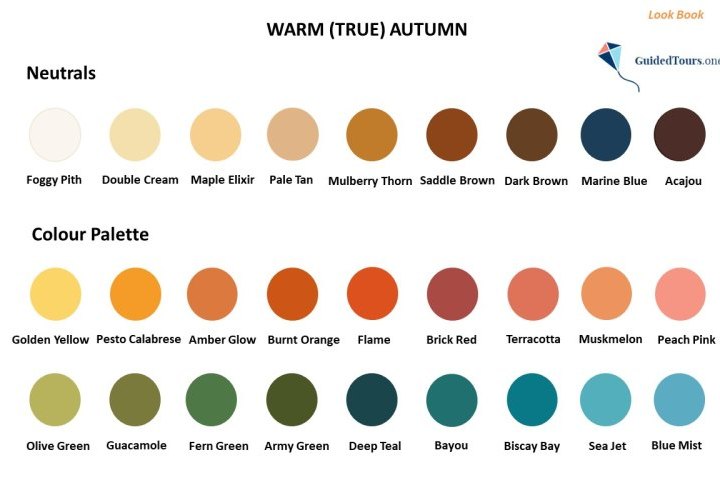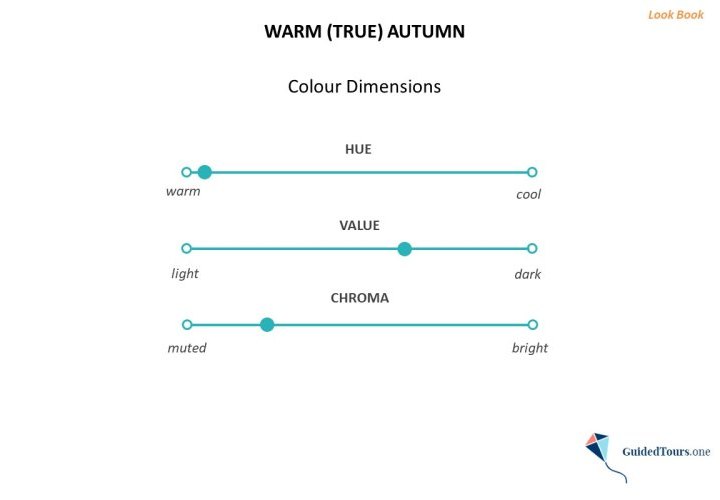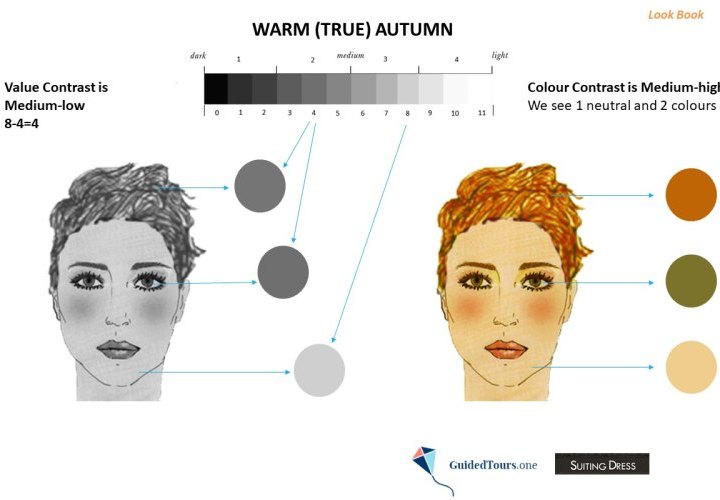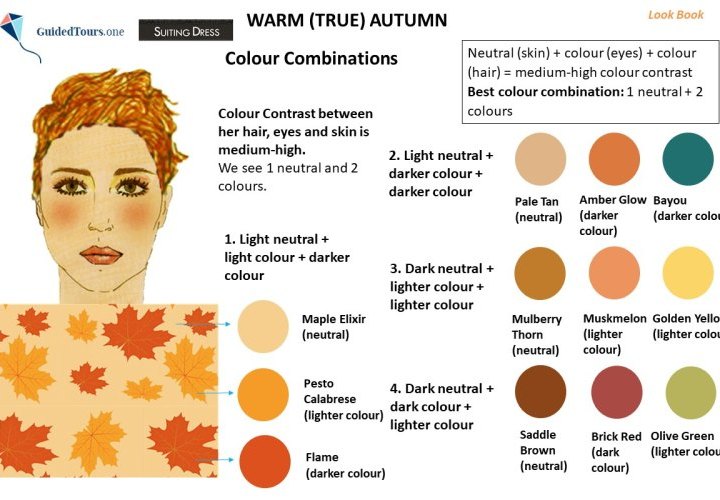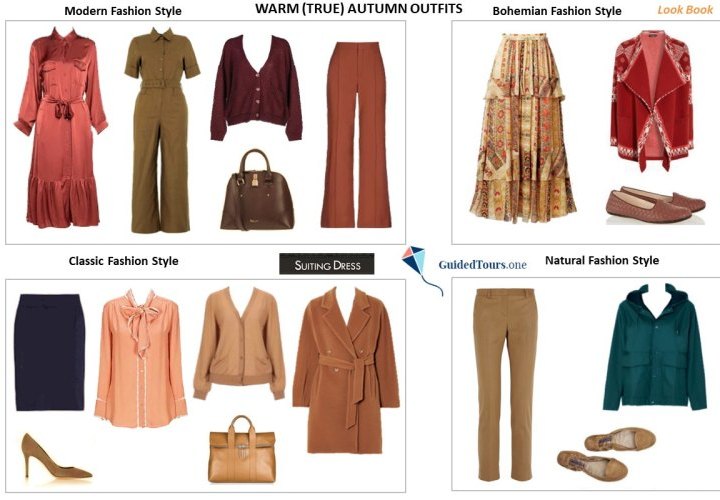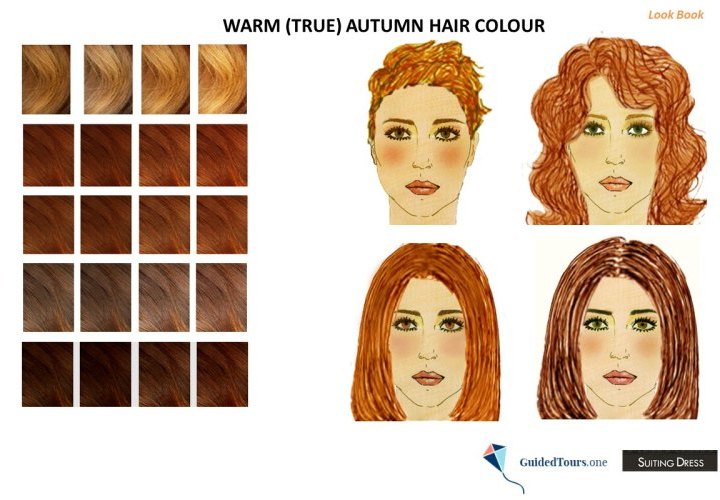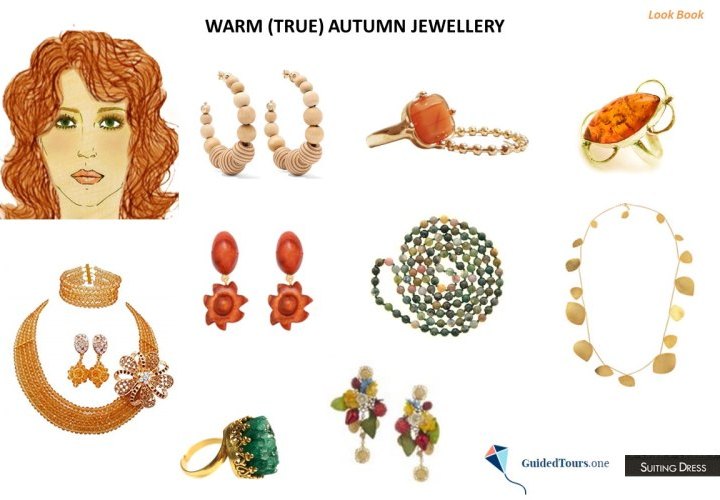If we examine the Colour Dimensions of Warm (True) Autumn (image 2) we can see that it is first of all warm, and then it is soft and after that dark.
Hue: Warm (Warm Autumn is the warmest season of the Autumn family, and this is the main colour aspect of this season type).
Value: Medium-dark (Warm Autumn colours can be lighter or darker, but overall the value is medium-dark, leaning slightly to the middle of the value scale). more
Chroma: Medium-soft (Warm Autumn has a medium-soft chroma, and it falls about in the middle on the soft right side of the scale).
Now, let’s examine the features (hair, skin tone, eyes) of Warm Autumn representatives.
Hair: Warm Autumn hair can be golden blonde, golden auburn, medium auburn, light golden brown, medium golden brown, and dark golden brown and can develop golden highlights when exposed to the sun.
Skin tone: Warm Autumn skin has a big range of skin tones, and can be fair, light, medium, tan or dark. The skin has clear warm undertones.
Eye Colours: Warm Autumn eyes are warm and come in a variety of colours. They are generally dark hazel, olive green, amber or golden brown and very rarely warm deep blue with a teal cast. The eyes can have both a halo and speckles within the iris and soft, swirling, and erratic borders surrounding the pupil. You may also notice the “Aztec Sun” pattern characteristic of Autumn eyes, which is a sun-like shape of mixed warm colours coming out from the pupil like a flame.
Colour Palette
Just like Warm Autumn’s primary colour dimensions, Warm (True) Autumn colours are warm, medium-soft, and medium-dark to be in line with this season type natural colouring.
The overall Warm Autumn Colour Palette (image 1) contains some of the warmest colours of the autumn family. The colours are mainly medium-dark, but there are many colours that are lighter or darker. There is not a hint of coolness in this palette.
The colours are at the warm end of the scale, so they are extremely warm with a clear yellow undertone. The colour palette includes many warm greens, golden yellows, orangey reds, and peachy pinks, but fewer tints and shades of blue, which is the coolest colour of all. The blues that you will find in the palette have a tint of yellow to make them warmer. Autumn is a season of soft/muted colours, but the colours included in the Warm/True Autumn Colour Palette appear rich and warm reminding us of the Autumn colourful leaves.
At the same time, there are many neutrals in the Warm Autumn palette, including foggy pith, double cream, saddle brown, and acajou. Warm Autumn neutrals include light neutrals, as well as dark ones. This mixture in value is needed to achieve a medium-low value contrast, as the contrast between this season type features (you will find more details about this in the next section). Black and white are not included in the palette, but Warm Autumns have their own “version” of black and white in the palette, most often foggy pith and acajou.
Warm Autumn worst colours are cool and bright, because they are opposed to warm and soft, the main colour aspects of this season type.
The value (or depth) shows how light or dark a colour is, while the value contrast is the level of difference in value between two or more colours. The closer together colours are, the lower is the level of contrast between them, and the farther apart colours are, the higher is the level of contrast.
Regardless of the values of Warm/True Autumn representatives features, there is usually a medium-low value contrast between them.
On the image on your right, you can see a Warm Autumn representative with medium-dark hair and eyes and a medium-light skin. In order to determine her value contrast level, we converted her photo into greyscale and assigned a value from 0 to 11 to her hair, skin, and eyes (4 to her hair, more
A) 0 - 2 (low value contrast)
B) 3 - 5 (medium-low value contrast)
C) 6 - 8 (medium-high value contrast)
D) 9 - 11 (high value contrast)
The medium-low value contrast, shows us that she can wear colours that provide a medium-low value contrast and her clothes should not be more than 4 values apart.
Following this example, you can examine your own features and see if there is a medium-low value contrast between them. Warm Autumns typically have a medium-low value contrast between their features.
Colour Contrast
In terms of colour contrast, Warm/True Autumns typically have a medium-low colour contrast, when two of their features are neutral and one feature has a colour in it, a medium-high colour contrast, when one of their features is neutral, and two features have a colour in them or a high colour contrast, when all their features have a colour in them.
On the image on your right, you can see that the Colour Contrast of the same Warm Autumn representative selected by us is medium-high, as we can see 1 neutral and 2 colours in her features: warm yellow beige skin (near neutral - beige with yellow undertone), golden auburn hair and darker olive green eyes. The best colour combination will be: 1 neutral + 2 colours.
Following this example, you can examine your own features and see if there is a medium-low colour contrast, a medium-high colour contrast or a high colour contrast between them. Warm Autumns typically have a medium-low colour contrast, a medium-high colour contrast or a high colour contrast between their features.
Therefore, Warm Autumn representatives can combine colours that provide a medium-low value contrast (taking into consideration the value contrast number), and the best combinations are those that repeat the value contrast level present in the appearance.
In terms of colour, the best colour combination for Warm Autumns with two neutral features and one feature that has a colour in it will be 2 neutrals and 1 colour, while the best colour combination for Warm Autumns with one neutral feature and two features that have a colour in them will be 2 colours and 1 neutral. more
The best colour combinations for Warm Autumn representatives (image 1), who have a medium-high colour contrast, are the following:
1. A light neutral + a light colour + a darker colour (1 neutral + 1 colour + 1 colour)
2. A light neutral + a darker colour + a darker colour (1 neutral + 1 colour + 1 colour)
3. A dark neutral + a lighter colour + a lighter colour (1 neutral + 1 colour + 1 colour)
4. A dark neutral + a dark colour + a lighter colour (1 neutral + 1 colour + 1 colour)
As our Warm Autumn representative has a medium-low value contrast, all colour combinations were chosen to create the same value contrast and they are only 4 values apart (except third one which is 3 values apart).
In terms of prints, the best patterns are those that only contain Warm Autumn colours, but if you can’t find a print that is completely within your palette, you can opt for a print that also has small colour spots from a disharmonious palette. The best prints for Warm Autumn are those that reflect the medium-low natural contrast level rather than ones which are too bold. The autumnal patterns with natural elements such as leaves and wood structures, as well as stylized flowers, oval shapes and unusual and extraordinary effects are great for Warm Autumns. The pattern should include elements that are loosely arranged and not too small or too dense. At the same time, retro geometric patterns are also fine.
Warm Autumns have a colourful palette with many options for various styles. On the image on your right (image 2), you can see some Warm (True) Autumn Colour Palette Outfits ideas belonging to modern, bohemian, classic, and natural fashion styles. You can experiment with the colours in your palette to create a medium-low value contrast, and find the style that works better for you (or combine styles).
Usually, the best hair colour for Warm Autumns is their natural hair colour, but if you want to change your natural hair colour, you should opt for another Warm Autumn hair colour. Ultimately, we all look our best when we are working with what is happening to us naturally, rather than drastically changing ourselves.
Advising and choosing a new hair colour is, above all, respecting your medium-low value contrast level and the natural warm base. Great hair colours for you would be all Warm Autumn natural hair colours mentioned above, as well as warm honey blonde, more
In terms of stones, turquoise, amber, carnelian, moss agate, rutilated quartz, and jasper are ideal for Warm Autumns. Brown pearls would also look great on Warm Autumns, but we suggest you to opt for faux pearls to show that you care about oysters and molluscs. Pearl extraction is not considered ethical, as oysters and other molluscs only produce pearls as a response to a stressful environment. Faux pearls can be just as beautiful as natural pearls, and they are ethical.
On the image on your right, you can see some pieces of Warm Autumn jewellery including earrings, more
If you are not sure whether you are a Warm (True) Autumn or not, you can contact us for an Online Personal Colour Analysis or purchase the Self Seasonal Colour Analysis Guide (15 €).

